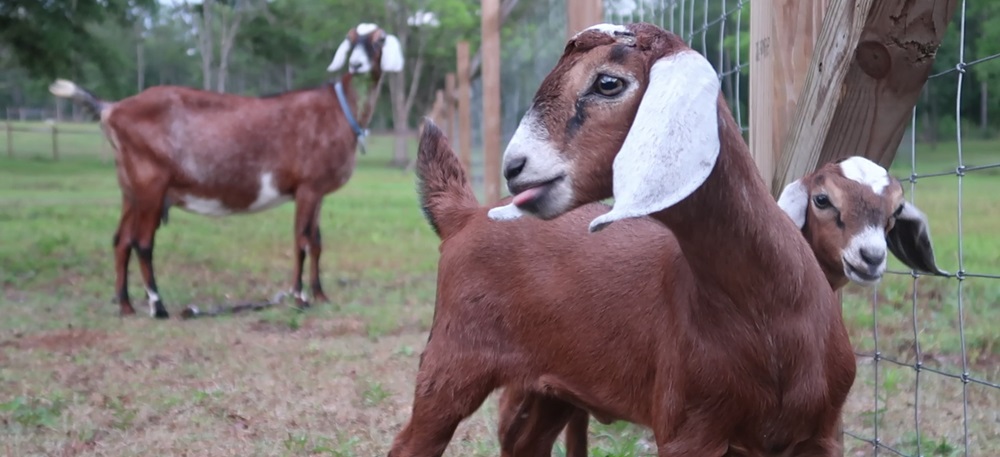Whinny’s Wisdoms

Hiya everybody, Whinny here! As goat enthusiasts and farmers, we cherish the benefits of goat milk – its creamy texture, rich flavor, and nutritional value. However, it’s essential to recognize that raw milk can harbor harmful pathogens, posing risks to both goat owners and consumers. In this blog post, we’ll explore zoonotic diseases associated with raw goat milk and discuss safe milk consumption practices to mitigate these risks effectively. So, saddle up and prepare for a journey into the murky depths of milk safety, guided by yours truly. That’s right, this mouse knows more than just cheese.
Whinny’s Wisdom: A zoonotic disease is an infectious disease caused by a pathogen–like bacteria, viruses, or parasites–that can be transmitted between animals and humans. In other words, it’s a disease that can naturally spread from animals to humans, either directly through contact with an infected animal or indirectly sources like contaminated food, water, or vectors such as mosquitoes or ticks.
Zoonotic Diseases Contracted from Raw Goat Milk
- Brucellosis:
Welcome to the world of Brucellosis, courtesy of the notorious Brucella melitensis. Consume raw milk contaminated with this bacterial troublemaker, and you’re in for a rendezvous with fever, accompanied by joint pain and fatigue. Testing goats regularly and pasteurizing milk are your best bets for prevention. Brucella melitensis is officially not found in Florida, however we do have a different type of Brucellosis which resides in the feral hog population. The risk still remains for any consuming raw goats milk from areas outside the state or country.
- Campylobacteriosis:
Ah, Campylobacter jejuni – the unwelcome guest lurking in goat intestines. Ingestion of contaminated raw milk can unleash a torrent of gastrointestinal distress, including diarrhea and abdominal pain. Maintain rigorous hygiene practices to keep this bug at bay. Campylobacter can also be found in other types of raw food–raw chicken a common culprit. Many farm animals can harbor this bacteria with no visible symptoms, so it is wise to treat all as potentially infected. Centers for Disease Control reports estimate 1.5 million people are infected with Campylobacter in the U.S yearly –yep, your mouse did her research!
- Salmonellosis:
Enter Salmonella, the insidious intruder that can infiltrate goat milk with alarming ease. Imbibe raw milk tainted with Salmonella, and you’ll find yourself grappling with symptoms like diarrhea and fever. This bug is especially dangerous to anyone with a compromised immune system– so children, older adults, pregnant people, and those with immune-mediated disease. Rigorous sanitation protocols and pasteurization are non-negotiable in safeguarding your milk supply.
- Listeriosis:
Meet Listeria monocytogenes, the stealthy saboteur of the bacterial world. Consumption of contaminated raw milk can trigger listeriosis, a potentially severe illness characterized by fever and muscle aches. Maintaining impeccable farm hygiene is paramount in mitigating this risk. Listeria can also make goats sick, most commonly with a neurologic brain disease called encephalitis, but it can also lead to abortion.
Whinny Wisdom – A direct quote from the FDA: Pregnant women run a serious risk of becoming ill from the bacteria Listeria, which is often found in raw milk and can cause miscarriage, or illness, or death of the newborn baby. If you are pregnant, drinking raw milk — or eating foods made from raw milk, such as Mexican-style cheese like Queso Blanco or Queso Fresco — can harm your baby even if you don’t feel sick.* Click here to read the article
- Cryptosporidiosis:
Enter Cryptosporidium, the minuscule menace with a knack for causing chaos. Ingestion of raw milk contaminated with Cryptosporidium can lead to cryptosporidiosis, marked by watery diarrhea and nausea. Vigilant husbandry practices are essential to ward off this microscopic threat. Even so, don’t be surprised if you come into contact with crypto if you keep goats or cattle, especially in more intensive systems like dairies. These teensy tiny protozoal parasites are very hard to remove from the environment and remain infective for quite a long time. They are so prevalent, in fact, that crypto is considered a common infection (and reason for missed class) of vet students who work with livestock.
- Q Fever:
Brace yourselves for Q Fever, courtesy of the elusive Coxiella burnetii. Consume raw milk teeming with this bacterium, and you’re in for a turbulent ride marked by high fever, severe headache, chest pain, and other flu-like signs. Q fever can also be spread through birthing fluids, placenta, and aborted fetal material from goats and sheep. Not every person exposed to this bug will become ill, but those that do are typically down for the count for 1-2 weeks. Pasteurization and robust biosecurity measures during kidding season offer your best defense against this insidious foe.

If I haven’t made you lactose-intolerant with my words, let’s talk about how to avoid these risks. Hint, it involves heat! Pasteurization is a widely used process that kills harmful bacteria by heating milk to a specific temperature for a set period of time. First developed by Louis Pasteur in 1864, pasteurization kills harmful organisms like those we’ve discussed so far. Don’t fret if you only have a few milking does and not a large factory. Pasteurization can be done relatively simply at home with a few simple tools!
Whinny Wisdom – Pasteurization does not change the nutritional value of milk, no matter what the sign at the Farmer’s Market says.
Pasteurization Process for Home Use:
- Wash hands and prepare a clean work area.
- Boil all containers and lids in water for at least 2-3 minutes to sterilize them.
- Using a double boiler, fill the bottom chamber with water and the top with your raw milk.
- Heat the double boiler up slowly on the stove. From here you have two options:
• Heat the milk to at least 150F for at least 30 minutes
• Heat the milk to at least 162F for at least 15 seconds - Use a thermometer to monitor the temperature and stir the milk regularly. Do not rest the thermometer on the bottom or sides of the pot.
- If the temperature drops below the goal temperature at any point, you must start timing again.
- Put the top part of the double boiler in an ice water bath (don’t get water in the milk) to cool it fast. Stir the milk often to cool it faster, until it reaches 68°F or cooler.
- Pour the cooled milk into your sterilized containers right away and store in the fridge. It is recommended to label the containers with the date pasteurized. So, there you have it – the raw truth about raw goat milk. While the allure of unpasteurized milk may be tempting, remember that safety should always reign supreme. So, embrace pasteurization, uphold impeccable hygiene, and savor your milk without the microbial mayhem. Stay smart, stay safe, and above all, stay vigilant, my fellow dairy enthusiasts! And if you aren’t subscribed to my blog, just scroll down a bit to the big purple box!
Until next week,
~Whinny
P.S. Do you know about the Companion Animal Clinic here at Springhill Equine? That’s right! Our clinic is a whole lot bigger than it used to be, and we now have a full small animal hospital! So in addition to your horses, donkeys, and goats, we’re ready to provide full veterinary care for your dogs and cats. Just give us a call to schedule your appointment at 352-472-1620. You can check out our new facility in this video:
 Whinny’s Wisdoms is the official blog of Whinny the Clinic Mouse at Springhill Equine Veterinary Clinic in Newberry, Florida. If you liked this blog, please subscribe below, and share it with your friends on social media! For more information, please call us at (352) 472-1620, visit our website at SpringhillEquine.com, or follow us on Facebook!
Whinny’s Wisdoms is the official blog of Whinny the Clinic Mouse at Springhill Equine Veterinary Clinic in Newberry, Florida. If you liked this blog, please subscribe below, and share it with your friends on social media! For more information, please call us at (352) 472-1620, visit our website at SpringhillEquine.com, or follow us on Facebook!
[jetpack_subscription_form title="Subscribe to Whinny's Wisdoms"]

